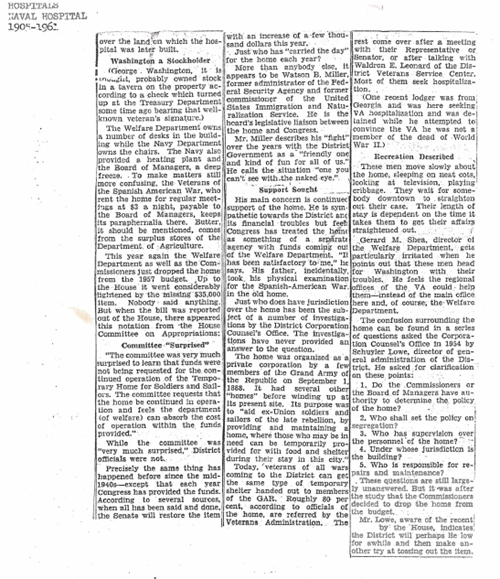

(Continued from page 1) over the land on which the hospital was later built.
(George Washington, it is thought, probably owned stock in a tavern on the property according to a check which turned up at the Treasury Department some time ago bearing that well-known veteran's signature.)
The Welfare Department owns a number of desks in the building while the Navy Department owns the chairs. The Navy also provided a heating plant and the Board of Managers, a deep freeze. To make matters still more confusing, the Veterans of the Spanish American War, who rent the home for regular meetings at $3 a night, payable to the Board of Managers, keeps its paraphernalia there. Butter, it should be mentioned, comes from the surplus stores of the Department of Agriculture.
This year again the Welfare Department as well as the Commissioners just dropped the home from the 1957 budget. Up to the House it went considerably lightened by the missing $35,000 item. Nobody said anything. But when the bill was reported out of the House, there appeared this notation from the House Committee on Appropriations:
“The committee was very much surprised to learn that funds were not being requested for the continued operation of the Temporary Home for Soldiers and Sailors. The committee requests that the home be continued in operation and feels the department (of welfare) can absorb the cost of operation within the funds provided.”
While the committee was “very much surprised,” District officials were not.
Precisely the same thing has happened before since the mid-1940s – except that each year Congress has provided the funds. According to several sources, when all has been said and done, the Senate will restore the item with an increase of a few thousand dollars this year.
Just who has “carried the day” for the home each year?
More than anybody else, it appears to be Watson B. Miller, former administrator of the Federal Security Agency and former commissioner of the United States Immigration and Naturalization Service. He is the board’s legislative liaison between the home and Congress.
Mr. Miller describes his “fight” over the years with the District Government as a “friendly one and kind of fun for all of us.” He calls the situation “one you can’t see with the naked eye.”
His main concern is continued support of the home. He is sympathetic towards the District and its financial troubles but feels Congress has treated the home as something of a separate agency with funds coming out of the Welfare Department. “It has been satisfactory to me,” he says. His father, incidentally, took his physical examination for the Spanish-American War in the old home.
Just who does have jurisdiction over the home has been the subject of a number of investigations by the District corporation Counsel’s Office. The investigations have never provided an answer to that question.
The home was organized as a private corporation by a few members of the Grand Army of the Republic on September 1, 1888. It had several other “homes” before winding up at its present site. Its purpose was to “aid ex-Union soldiers and sailors of the late rebellion, by providing and maintaining a home, where those who may be in need can be temporarily provided for with food and shelter during their stay in this city.”
Today, veterans of all wars coming to the District can get the same type of temporary shelter handed out to members of the GAR. Roughly 80 percent, according to officials of the home, are referred by the Veterans Administration. The rest come over after a meeting with their Representative or Senator, or after talking with Waldron E. Leonard of the District Veterans Service Center. Most of them seek hospitalization.
(One recent lodger was from Georgia and was here seeking VA hospitalization and was detained while he attempted to convince the VA he was not a member of the dead of World War II.)
These men move slowly about the home, sleeping on neat cots, looking at television, playing cribbage. They wait for somebody downtown to straighten out their case. Their length of stay is dependent on the time it takes to get their affairs straightened out.
Gerard M. Shea, director of the Welfare Department, get particularly irritated when he points out that these men head for Washington with their troubles. He feels the regional offices of the VA could help them – instead of the main office here and, of course, the Welfare Department.
The confusion surrounding the home can e found in a series of questions asked the Corporation Counsel’s Office in 1954 by Schuyler Lowe, director of general administration of the District. He asked for clarification on these points;
1. Do the Commissioners or the Board of Managers have authority to determine the policy of the home?
2. Who shall set the policy on segregation?
3. Who has supervision over the personnel of the home?
4. Under whose jurisdiction is the building?
5. Who is responsible for repairs and maintenance?
These questions are still largely unanswered. But it was after the study that the Commissioners decided to drop the home from the budget.
Mr. Lowe, aware of the recent action by the House, indicates the District will perhaps lie low for awhile and then make another try at tossing out the item.
This site is sponsored by the Friends of the Old Naval Hospital
Last updated July 27, 2009